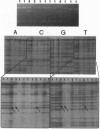Abstract
The life history of Candida albicans presents an enigma: this species is thought to be exclusively asexual, yet strains show extensive phenotypic variation. To address the population genetics of C. albicans, we developed a genetic typing method for codominant single-locus markers by screening randomly amplified DNA for single-strand conformation polymorphisms. DNA fragments amplified by arbitrary primers were initially screened for single-strand conformation polymorphisms and later sequenced using locus-specific primers. A total of 12 single base mutations and insertions were detected from six out of eight PCR fragments. Patterns of sequence-level polymorphism observed for individual strains detected considerable heterozygosity at the DNA sequence level, supporting the view that most C. albicans strains are diploid. Population genetic analyses of 52 natural isolates from Duke University Medical Center provide evidence for both clonality and recombination in C. albicans. Evidence for clonality is supported by the presence of several overrepresented genotypes, as well as by deviation of genotypic frequencies from random (Hardy-Weinberg) expectations. However, tests for nonrandom association of alleles across loci reveal less evidence for linkage disequilibrium than expected for strictly clonal populations. Although C. albicans populations are primarily clonal, evidence for recombination suggests that sexual reproduction or some other form of genetic exchange occurs in this species.
Full text
PDF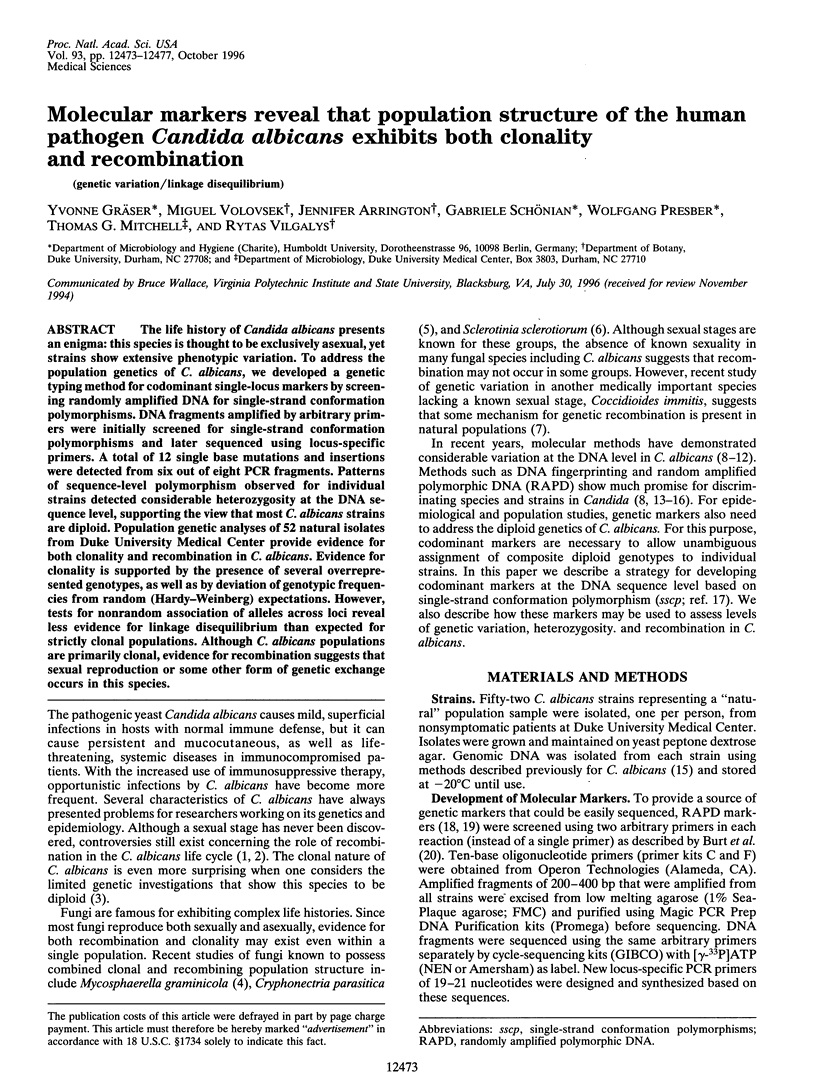
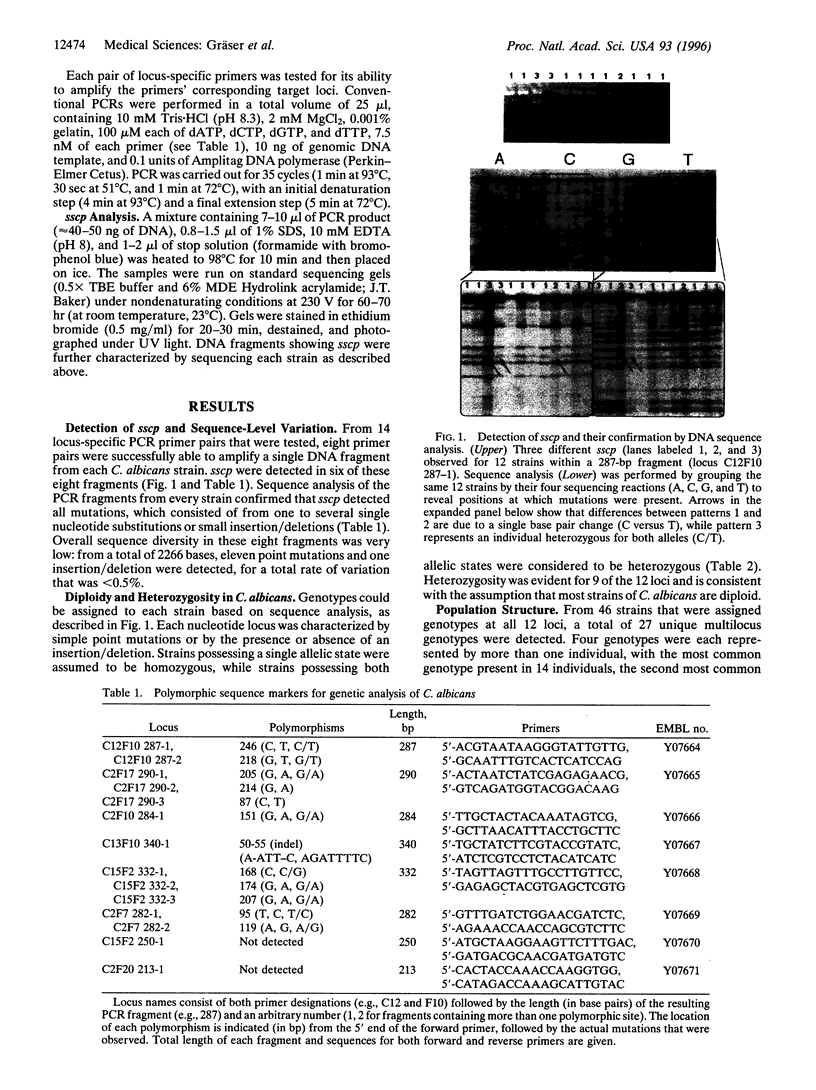
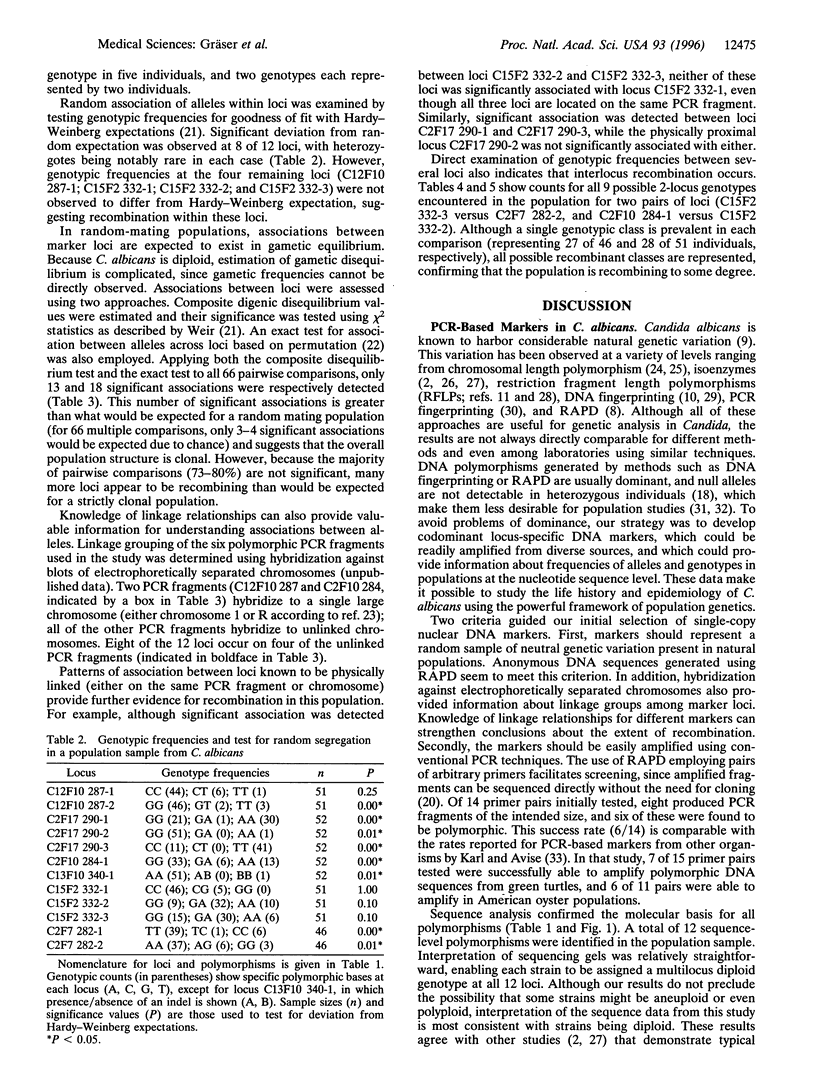
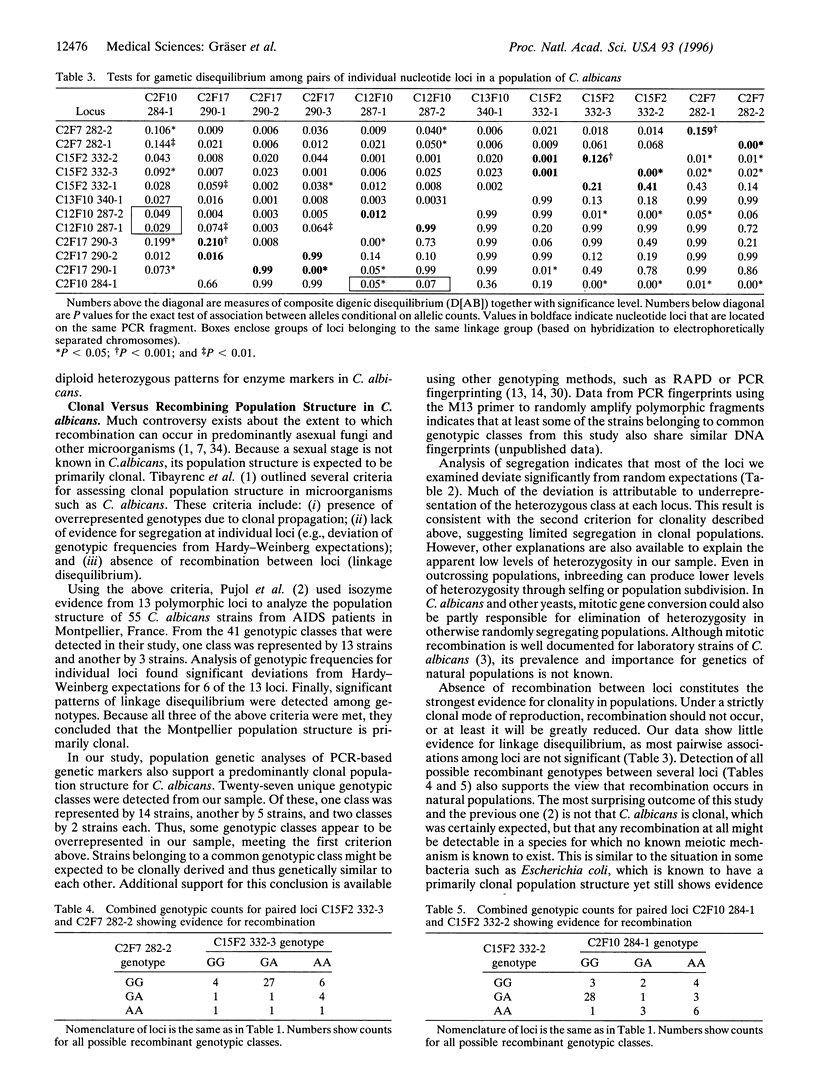
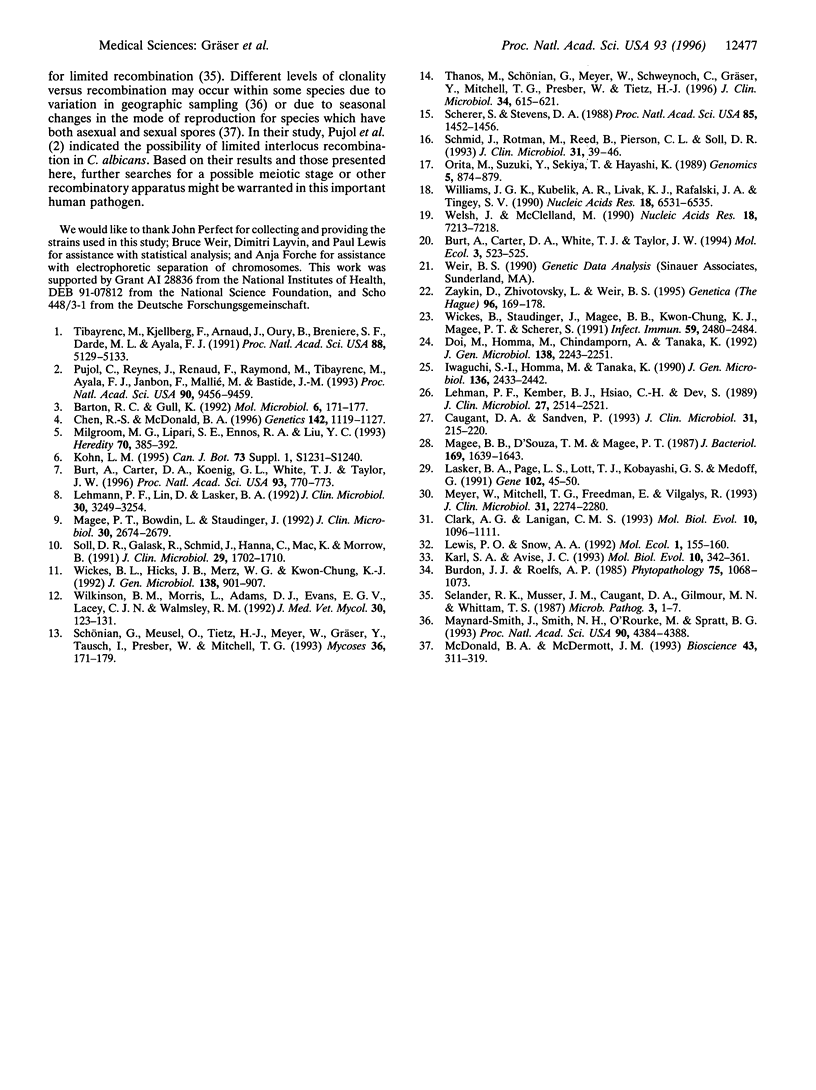
Images in this article
Selected References
These references are in PubMed. This may not be the complete list of references from this article.
- Barton R. C., Gull K. Isolation, characterization, and genetic analysis of monosomic, aneuploid mutants of Candida albicans. Mol Microbiol. 1992 Jan;6(2):171–177. doi: 10.1111/j.1365-2958.1992.tb01998.x. [DOI] [PubMed] [Google Scholar]
- Burt A., Carter D. A., Koenig G. L., White T. J., Taylor J. W. Molecular markers reveal cryptic sex in the human pathogen Coccidioides immitis. Proc Natl Acad Sci U S A. 1996 Jan 23;93(2):770–773. doi: 10.1073/pnas.93.2.770. [DOI] [PMC free article] [PubMed] [Google Scholar]
- Burt A., Carter D. A., White T. J., Taylor J. W. DNA sequencing with arbitrary primer pairs. Mol Ecol. 1994 Oct;3(5):523–525. doi: 10.1111/j.1365-294x.1994.tb00131.x. [DOI] [PubMed] [Google Scholar]
- Caugant D. A., Sandven P. Epidemiological analysis of Candida albicans strains by multilocus enzyme electrophoresis. J Clin Microbiol. 1993 Feb;31(2):215–220. doi: 10.1128/jcm.31.2.215-220.1993. [DOI] [PMC free article] [PubMed] [Google Scholar]
- Chen R. S., McDonald B. A. Sexual reproduction plays a major role in the genetic structure of populations of the fungus Mycosphaerella graminicola. Genetics. 1996 Apr;142(4):1119–1127. doi: 10.1093/genetics/142.4.1119. [DOI] [PMC free article] [PubMed] [Google Scholar]
- Clark A. G., Lanigan C. M. Prospects for estimating nucleotide divergence with RAPDs. Mol Biol Evol. 1993 Sep;10(5):1096–1111. doi: 10.1093/oxfordjournals.molbev.a040057. [DOI] [PubMed] [Google Scholar]
- Doi M., Homma M., Chindamporn A., Tanaka K. Estimation of chromosome number and size by pulsed-field gel electrophoresis (PFGE) in medically important Candida species. J Gen Microbiol. 1992 Oct;138(10):2243–2251. doi: 10.1099/00221287-138-10-2243. [DOI] [PubMed] [Google Scholar]
- Iwaguchi S., Homma M., Tanaka K. Variation in the electrophoretic karyotype analysed by the assignment of DNA probes in Candida albicans. J Gen Microbiol. 1990 Dec;136(12):2433–2442. doi: 10.1099/00221287-136-12-2433. [DOI] [PubMed] [Google Scholar]
- Karl S. A., Avise J. C. PCR-based assays of mendelian polymorphisms from anonymous single-copy nuclear DNA: techniques and applications for population genetics. Mol Biol Evol. 1993 Mar;10(2):342–361. doi: 10.1093/oxfordjournals.molbev.a040002. [DOI] [PubMed] [Google Scholar]
- Lasker B. A., Page L. S., Lott T. J., Kobayashi G. S., Medoff G. Characterization of CARE-1: Candida albicans repetitive element-1. Gene. 1991 Jun 15;102(1):45–50. doi: 10.1016/0378-1119(91)90536-k. [DOI] [PubMed] [Google Scholar]
- Lehmann P. F., Kemker B. J., Hsiao C. B., Dev S. Isoenzyme biotypes of Candida species. J Clin Microbiol. 1989 Nov;27(11):2514–2521. doi: 10.1128/jcm.27.11.2514-2521.1989. [DOI] [PMC free article] [PubMed] [Google Scholar]
- Lehmann P. F., Lin D., Lasker B. A. Genotypic identification and characterization of species and strains within the genus Candida by using random amplified polymorphic DNA. J Clin Microbiol. 1992 Dec;30(12):3249–3254. doi: 10.1128/jcm.30.12.3249-3254.1992. [DOI] [PMC free article] [PubMed] [Google Scholar]
- Lewis P. O., Snow A. A. Deterministic paternity exclusion using RAPD markers. Mol Ecol. 1992 Oct;1(3):155–160. doi: 10.1111/j.1365-294x.1992.tb00171.x. [DOI] [PubMed] [Google Scholar]
- Magee B. B., D'Souza T. M., Magee P. T. Strain and species identification by restriction fragment length polymorphisms in the ribosomal DNA repeat of Candida species. J Bacteriol. 1987 Apr;169(4):1639–1643. doi: 10.1128/jb.169.4.1639-1643.1987. [DOI] [PMC free article] [PubMed] [Google Scholar]
- Magee P. T., Bowdin L., Staudinger J. Comparison of molecular typing methods for Candida albicans. J Clin Microbiol. 1992 Oct;30(10):2674–2679. doi: 10.1128/jcm.30.10.2674-2679.1992. [DOI] [PMC free article] [PubMed] [Google Scholar]
- Meyer W., Mitchell T. G., Freedman E. Z., Vilgalys R. Hybridization probes for conventional DNA fingerprinting used as single primers in the polymerase chain reaction to distinguish strains of Cryptococcus neoformans. J Clin Microbiol. 1993 Sep;31(9):2274–2280. doi: 10.1128/jcm.31.9.2274-2280.1993. [DOI] [PMC free article] [PubMed] [Google Scholar]
- Orita M., Suzuki Y., Sekiya T., Hayashi K. Rapid and sensitive detection of point mutations and DNA polymorphisms using the polymerase chain reaction. Genomics. 1989 Nov;5(4):874–879. doi: 10.1016/0888-7543(89)90129-8. [DOI] [PubMed] [Google Scholar]
- Pujol C., Reynes J., Renaud F., Raymond M., Tibayrenc M., Ayala F. J., Janbon F., Mallié M., Bastide J. M. The yeast Candida albicans has a clonal mode of reproduction in a population of infected human immunodeficiency virus-positive patients. Proc Natl Acad Sci U S A. 1993 Oct 15;90(20):9456–9459. doi: 10.1073/pnas.90.20.9456. [DOI] [PMC free article] [PubMed] [Google Scholar]
- Scherer S., Stevens D. A. A Candida albicans dispersed, repeated gene family and its epidemiologic applications. Proc Natl Acad Sci U S A. 1988 Mar;85(5):1452–1456. doi: 10.1073/pnas.85.5.1452. [DOI] [PMC free article] [PubMed] [Google Scholar]
- Schmid J., Rotman M., Reed B., Pierson C. L., Soll D. R. Genetic similarity of Candida albicans strains from vaginitis patients and their partners. J Clin Microbiol. 1993 Jan;31(1):39–46. doi: 10.1128/jcm.31.1.39-46.1993. [DOI] [PMC free article] [PubMed] [Google Scholar]
- Schönian G., Meusel O., Tietz H. J., Meyer W., Gräser Y., Tausch I., Presber W., Mitchell T. G. Identification of clinical strains of Candida albicans by DNA fingerprinting with the polymerase chain reaction. Mycoses. 1993 May-Jun;36(5-6):171–179. doi: 10.1111/j.1439-0507.1993.tb00746.x. [DOI] [PubMed] [Google Scholar]
- Selander R. K., Musser J. M., Caugant D. A., Gilmour M. N., Whittam T. S. Population genetics of pathogenic bacteria. Microb Pathog. 1987 Jul;3(1):1–7. doi: 10.1016/0882-4010(87)90032-5. [DOI] [PubMed] [Google Scholar]
- Smith J. M., Smith N. H., O'Rourke M., Spratt B. G. How clonal are bacteria? Proc Natl Acad Sci U S A. 1993 May 15;90(10):4384–4388. doi: 10.1073/pnas.90.10.4384. [DOI] [PMC free article] [PubMed] [Google Scholar]
- Soll D. R., Galask R., Schmid J., Hanna C., Mac K., Morrow B. Genetic dissimilarity of commensal strains of Candida spp. carried in different anatomical locations of the same healthy women. J Clin Microbiol. 1991 Aug;29(8):1702–1710. doi: 10.1128/jcm.29.8.1702-1710.1991. [DOI] [PMC free article] [PubMed] [Google Scholar]
- Thanos M., Schonian G., Meyer W., Schweynoch C., Graser Y., Mitchell T. G., Presber W., Tietz H. J. Rapid identification of Candida species by DNA fingerprinting with PCR. J Clin Microbiol. 1996 Mar;34(3):615–621. doi: 10.1128/jcm.34.3.615-621.1996. [DOI] [PMC free article] [PubMed] [Google Scholar]
- Tibayrenc M., Kjellberg F., Arnaud J., Oury B., Brenière S. F., Dardé M. L., Ayala F. J. Are eukaryotic microorganisms clonal or sexual? A population genetics vantage. Proc Natl Acad Sci U S A. 1991 Jun 15;88(12):5129–5133. doi: 10.1073/pnas.88.12.5129. [DOI] [PMC free article] [PubMed] [Google Scholar]
- Welsh J., McClelland M. Fingerprinting genomes using PCR with arbitrary primers. Nucleic Acids Res. 1990 Dec 25;18(24):7213–7218. doi: 10.1093/nar/18.24.7213. [DOI] [PMC free article] [PubMed] [Google Scholar]
- Wickes B. L., Hicks J. B., Merz W. G., Kwon-Chung K. J. The molecular analysis of synonymy among medically important yeasts within the genus Candida. J Gen Microbiol. 1992 May;138(5):901–907. doi: 10.1099/00221287-138-5-901. [DOI] [PubMed] [Google Scholar]
- Wickes B., Staudinger J., Magee B. B., Kwon-Chung K. J., Magee P. T., Scherer S. Physical and genetic mapping of Candida albicans: several genes previously assigned to chromosome 1 map to chromosome R, the rDNA-containing linkage group. Infect Immun. 1991 Jul;59(7):2480–2484. doi: 10.1128/iai.59.7.2480-2484.1991. [DOI] [PMC free article] [PubMed] [Google Scholar]
- Wilkinson B. M., Morris L., Adams D. J., Evans E. G., Lacey C. J., Walmsley R. M. A new, sensitive polynucleotide probe for distinguishing Candida albicans strains and its use with a computer assisted archiving and pattern comparison system. J Med Vet Mycol. 1992;30(2):123–131. [PubMed] [Google Scholar]
- Williams J. G., Kubelik A. R., Livak K. J., Rafalski J. A., Tingey S. V. DNA polymorphisms amplified by arbitrary primers are useful as genetic markers. Nucleic Acids Res. 1990 Nov 25;18(22):6531–6535. doi: 10.1093/nar/18.22.6531. [DOI] [PMC free article] [PubMed] [Google Scholar]
- Zaykin D., Zhivotovsky L., Weir B. S. Exact tests for association between alleles at arbitrary numbers of loci. Genetica. 1995;96(1-2):169–178. doi: 10.1007/BF01441162. [DOI] [PubMed] [Google Scholar]



